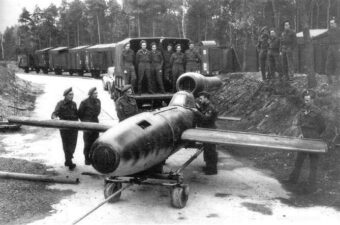“Unveiling the Bizarre: How Nazi Germany Crafted a Wooden Weapon of War That Defied Belief”
“Shattered fuselages, broken-off wings, ripped-out engines, shards of aluminium and fragments of every size whirled through the air. It looked as if someone had emptied out an ashtray.”
It was also proposed to arm the Natter with the same 30mm MK 108 autocannon as the Me-262 and even a concrete nose for use in ramming attack, though Erich Bachem vehemently nixed the latter proposal, insisting that his design was not a suicide weapon. Indeed, the Natter’s pilot was provided with a steel armour plate behind his seat and an armoured windscreen to increase his chances of surviving a mission.
Once his main armament was expended, the Natter pilot would quickly descend to an altitude of around 3,000 metres, flatten out his glide slope, and initiate the escape sequence. This involved the pilot unlatching his harness, jettisoning the canopy, and releasing a lock at the base of his control column. This allowed him to tilt the column forward and unlock the nose release mechanism. He would then pull another lever on the cockpit floor to release the nose, which would be pulled free of the fuselage by aerodynamic forces. This, in turn, would deploy a small ribbon parachute from the fuselage, pulling it away and throwing the pilot forward via inertia. Once clear of the aircraft, the pilot would open his own parachute and descend to the ground, while the rear fuselage parachuted separately for eventual recovery and reuse. Each mission would take less than 10 minutes from start to finish, with the Natter having an operation radius of around 12 kilometres – enough to defend a single factory or other strategic site. This made the Natter a form of point defence interceptor – a role now largely filled by unmanned guided missiles.











